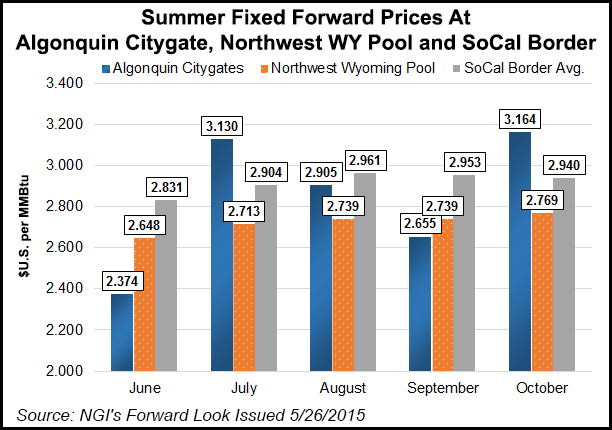Strong Shale Production, Mild Temps to Keep Summer Natural Gas Demand in Check
Thanks to a strong El Nino event that is expected to sweep the United States this summer and ward off significant heat waves in key population centers, the demand for air conditioning is expected to be on the low side, which in turn will keep pressure off of natural gas supplies, according to Weather Services International (WSI) and ESAI Power LLC.

WSI reported Tuesday that the June-August forecast, which references a standard 30-year normal (1981-2010), indicates below-normal temperatures in most areas east of the Rockies, with above-normal temperatures expected across the western U.S.
“The latest observations and model forecasts suggest that the emerging El Nino event will be potent this year, likely stronger than the 2009 event and possibly rivaling the 1997 event,” said WSI Chief Meteorologist Todd Crawford. “The downstream impacts from El Ninowill likely drive decreased risk of big heat this summer in the Eastern and Central U.S., especially later in the summer. Our current 2015 summer forecast for national cooling demand rivals the cool summer of 2009 and even this may be a bit conservative.”
Despite the overall mild summer picture, June will kick off the season on the warm side, with the entire East and West seeing warmer-than-normal temperatures, while the entire middle of the country sees cooler-than-normal conditions.
Chris Kostas, senior power and gas analyst at ESAI Power LLC, sees the regions offsetting each other in terms of energy demand. “Although June temperatures on the East and the West Coasts are expected to run slightly warmer than normal, the much-cooler-than-normal temperatures expected in June over the central part of the country should mean aggregate weather-related demand will be weak,” he said. “Gas demand on a weather normalized basis, however, will run strong compared to 2014 due to coal-fired generator retirements that occurred this spring (as a result of emissions regulations that went into effect in April 2015).
“Gas prices will remain weak, particularly in the Midwest where shale gas production remains strong and year-over-year inventory levels remain high,” he added. “Inventories are running nearly 60% above same-time-last year levels. Power prices in California will be supported by low hydroelectric generation this year.”
As the United States enters July, the middle of the country will remain cooler than normal, but will be joined by the Northeast and Southwest with below normal temperatures, according to WSI. Meanwhile, the Southeast and Northwest will experience warmer-than-normal conditions.
Kostas said July’s much cooler than normal temperatures will translate into weak weather-related energy demand. “Gas prices will be soft as a result of below normal demand and a strong supply picture,” he said. “Year-over-year gas production will be running about 4 Bcf/d higher this year (compared to last year), and inventory demand in July will run two to three Bcf/d below last year. In addition, gas prices in the Midwest and Northeast will retain large discounts to Henry Hub as a result of the continued growth of Marcellus and Utica shale gas production.”
Conditions don’t get a whole lot better for energy bulls in August if WSI’s forecast for the month comes to fruition. The East and middle of the country are expected to be cooler than normal, with the exceptions of Florida and South Texas, while the West is expected to see warmer-than-normal temperatures.
ESAI’s Kostas said energy demand will remain weak during the month, especially as stout shale gas production is expected to continue. “Gas prices, and by extension power prices, will be soft in August as a result of the tepid demand that is expected. Marcellus and Utica production should remain strong and help to keep gas prices soft, particularly in the Midwest where steep discounts to Henry Hub can be expected,” he added. “Provided there are no significant heat waves, and considering lower hydro generation, California could escape the 2015 summer without too much trouble.”
WSI will publish an update to its summer seasonal forecast on June 23.
© 2024 Natural Gas Intelligence. All rights reserved.
ISSN © 1532-1231 | ISSN © 2577-9877 | ISSN © 1532-1266 |
